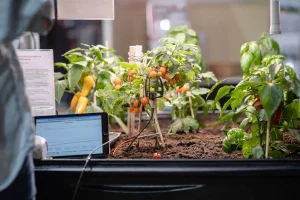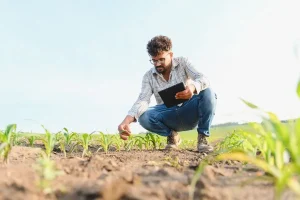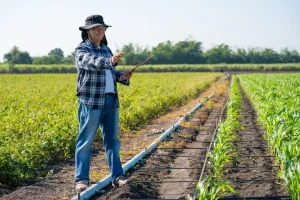The Remote Irrigation System is being developed to save water and energy in modern agriculture. In addition, thanks to sensor and automation technologies, soil moisture and climate data can be monitored in real time. Therefore, irrigation programs can be planned remotely and managed precisely. This way, plants can be given the water they need at the right time and in the right amount. Furthermore, the system can be continuously monitored via mobile devices. In this case, fault detection and maintenance operations can be performed quickly. Therefore, labor and time losses can be minimized. In addition, environmentally friendly production can be achieved by preventing unnecessary water loss. In this way, costs can be reduced and profitability increased. Furthermore, the remote irrigation system can easily adapt to different climate conditions and terrain structures.
Contents
- Remote Irrigation Solutions
- Automatic Irrigation System
- Remote Irrigation System via Phone
- Remote Controlled Irrigation
- Smart Solution
- Conclusion
- Frequently Asked Questions
Remote Irrigation Solutions
Remote Irrigation Solutions are developed to ensure water and energy efficiency in modern agriculture. Additionally, soil moisture and weather conditions can be continuously monitored using sensor and automation technologies. Therefore, irrigation programs can be planned remotely and managed precisely. This way, plants can be provided with the water they need at the right time and in the right amount. Furthermore, real-time control is possible via mobile devices. This allows for quick troubleshooting and maintenance. Consequently, labor and time losses are minimized. Unnecessary water losses are also prevented, enabling environmentally friendly and sustainable production. This reduces production costs and increases profitability.

Automatic Irrigation System
The Automatic Irrigation System is developed to increase water and energy efficiency in agricultural production. Additionally, thanks to sensor and automation technologies, soil moisture and weather conditions can be monitored in real-time. Therefore, irrigation programs can be applied at the right time and in the right amount. In this way, the water required by plants can be provided in a balanced manner. It can also be controlled remotely via mobile devices. In this case, fault detection and maintenance operations can be carried out quickly. This minimizes labor and time losses. Furthermore, unnecessary water losses are prevented, supporting environmentally friendly and sustainable production. This reduces production costs and increases profitability. The automatic irrigation system can also easily adapt to different climatic conditions and terrain structures. This allows both large and small agricultural areas to be irrigated safely.

Remote Irrigation System via Phone
The Remote Irrigation System via Phone is being developed to ensure water and energy efficiency in modern agriculture. Additionally, thanks to sensor and automation technologies, soil moisture and climate data can be monitored in real-time. Therefore, irrigation programs can be planned and precisely managed from a mobile phone. This way, plants can receive the water they need at the right time and in the correct amount. Furthermore, with mobile application support, all irrigation areas can be controlled from a single screen. In this case, fault detection and maintenance planning can be done quickly. Therefore, labor and time losses can be minimized. Unnecessary water loss is prevented, supporting eco-friendly, sustainable production. Production costs drop and profitability rises. The phone-based remote irrigation system adapts to various climates and terrains, allowing safe irrigation of farms large or small.

Remote Controlled Irrigation
Remote Controlled Irrigation is being developed to increase water and energy efficiency in modern agriculture. Additionally, thanks to sensor and automation technologies, soil moisture and weather conditions can be continuously monitored. Therefore, irrigation programs can be precisely managed via mobile phone or computer. This ensures that plants receive the water they need at the right time and in the correct amount. Furthermore, real-time control of irrigation areas can be achieved through mobile applications. In this case, fault detection and maintenance operations can be carried out quickly. Therefore, labor and time losses can be minimized. Furthermore, unnecessary water loss is prevented, supporting environmentally friendly and sustainable production. This reduces production costs and increases profitability. Remote-controlled irrigation can also easily adapt to different climatic conditions and terrain structures. This allows both large and small agricultural areas to be irrigated safely.

Smart Solution
Smart Solutions are developed to increase efficiency and reduce costs in modern life. Additionally, processes can be managed precisely with the support of sensors, automation, and artificial intelligence. Therefore, resources can be used effectively by accurately analyzing needs. This enables savings in energy, water, and time. Furthermore, remote monitoring and control capabilities are offered. In this case, fault detection and maintenance planning can be carried out quickly. Therefore, operational disruptions can be minimized. In addition, data analysis enables reliable planning for the future. This speeds up decision-making processes. As a result, production and service quality can be continuously improved. Furthermore, sustainability goals can be supported with environmentally friendly working principles. In this case, the carbon footprint can be reduced. In this way, businesses can gain long-term environmental and economic advantages.

Conclusion
As a result, the Remote Irrigation System is a reliable technology that saves water and energy in agricultural production. Additionally, the Remote Irrigation System can precisely manage irrigation programs with sensor and automation support. Therefore, plants can receive the water they need at the right time and in the right amount. This way, product quality and productivity can be increased. Moreover, thanks to its mobile access feature, farmers can easily control irrigation processes from anywhere. In this case, fault detection and maintenance planning can be done quickly. Therefore, production costs can be reduced and labor savings can be achieved. In addition, with its environmentally friendly working principle, water resources are protected and sustainable agriculture is supported. Thus, the Remote Irrigation System offers a strategic solution for modern and long-term agricultural investments.
Frequently Asked Questions
How do remote irrigation solutions work? They manage irrigation by analyzing soil moisture and climate data using sensor and automation technology.
For which agricultural areas are they suitable? They can be used safely in vegetable, fruit, vineyard, and large agricultural fields.
How do they save water and energy? They prevent water and energy loss by delivering the required amount of water at the right time.
Can it be controlled from mobile devices? Yes, the system can be managed from mobile devices anywhere with an internet connection.
How does it adapt to weather changes? It can automatically update the irrigation plan with real-time climate data.
Is fertilization and pesticide application integration possible? Yes, it works in conjunction with fertilizer injection systems to distribute nutrients evenly.
What factors determine the installation cost? It may vary depending on the size of the land, topography, and the selected technology.
How are faults detected and maintenance performed? System sensors provide alerts, enabling quick detection of faults.
Can it be used in small-scale agricultural areas? Yes, thanks to its scalable structure, it can also be adapted to small gardens.
What is its environmental contribution? It contributes to the conservation of natural resources and sustainable production by reducing water waste.

 English
English
 Türkçe
Türkçe
 Ελληνικά
Ελληνικά
 Deutsch
Deutsch
 ქართული
ქართული
 العربية
العربية








